How Many Kittens Can a Feral Cat Have in a Lifetime?
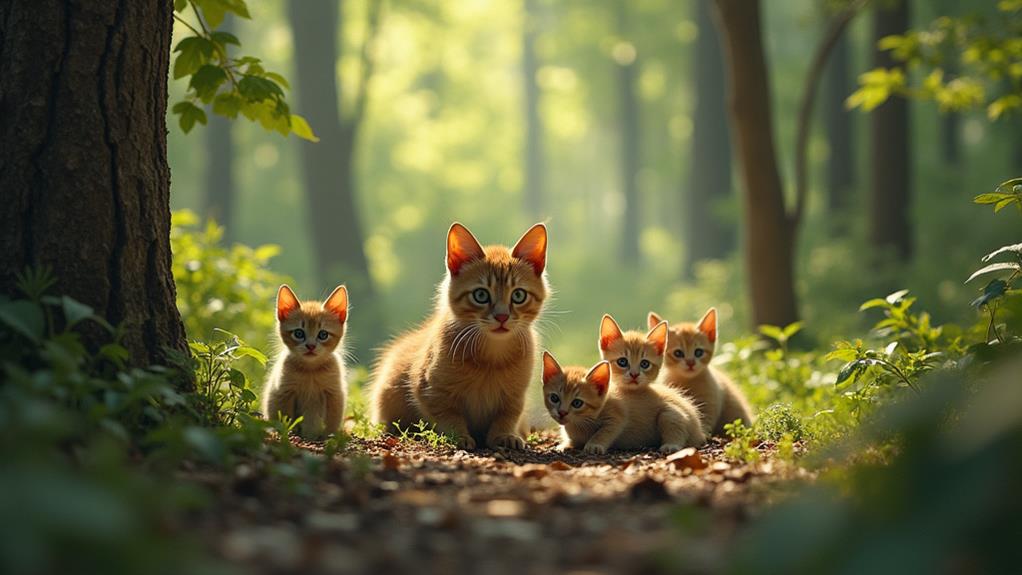
If you're curious about the prolific nature of feral cats, a single female can have an astonishing number of kittens throughout her lifetime. Each year, she might produce 2-3 litters, each with 2-6 kittens, resulting in up to 18 kittens annually. Over her lifetime, this can amount to between 100 and 300 kittens. With offspring capable of reproducing early, the total impact is exponentially larger, potentially skyrocketing to over 400,000 kittens in just seven years. Such growth highlights the importance of population control efforts like TNR programs. There's fascinating insight into how communities can manage this situation further.
Understanding Feral Cats
When you engage yourself in the world of feral cats, you'll uncover that these are not just stray cats looking for a home; they're domestic cats that have reverted to a wild state. Living in colonies around food sources, feral cats have adapted to a life without human contact, often thriving in environments that challenge their survival instincts. One of the most pressing issues with feral cats is their rapid reproduction rate. Just one female cat, if not spayed, can produce up to five litters annually. This can result in an astonishing 20-30 new feral cats each year, contributing notably to the estimated 60-100 million feral cats in the U.S.
Because of their unsocialized nature, feral cats are generally not adoptable, making population management a vital concern. One effective method is Trap-Neuter-Return (TNR), which involves capturing feral cats, then spaying or neutering them before returning them to their colonies. This humane approach helps curb the burgeoning population and extends the cats' average lifespan, which is unfortunately just 2-3 years compared to the 12-15 years of indoor cats. Understanding feral cats is essential for addressing the challenges they present and ensuring their welfare.
Feral vs. Stray Cats
Distinguishing between feral and stray cats can dramatically impact how we manage these feline populations. Feral cats are unsocialized, often living in colonies around food sources, and they typically shy away from human contact. They give birth to feral kittens, who grow up without human interaction and often share their parents' wariness of people. On the other hand, stray cats are usually domesticated. They might be lost or abandoned pets that have become separated from their human families. Unlike their feral counterparts, stray cats are more likely to approach humans, seeking food or attention.
One key difference is that feral cats are generally not adoptable due to their wild behavior. They thrive best in their natural environment, contributing to the stability of cat populations without human interference. Stray cats, however, can often be re-socialized, making them suitable candidates for adoption through shelters. Misidentifying stray cats as feral can lead to ineffective management strategies, overlooking the potential for these cats to find homes. Understanding these distinctions is crucial for crafting community intervention programs that address the unique needs of both feral kittens and stray cats, ensuring balanced and humane solutions for all.
Reproductive Cycle
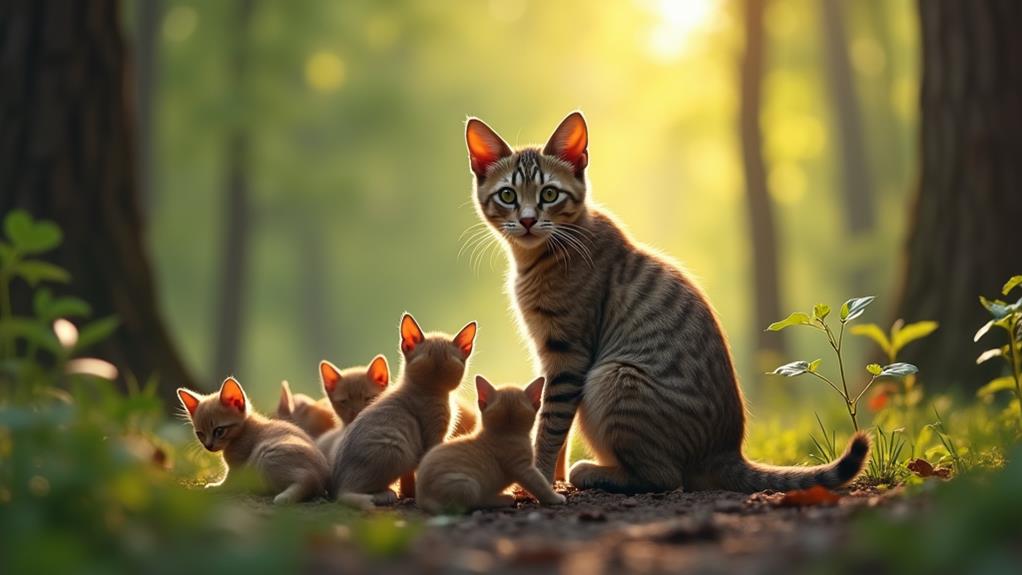
Remarkably, feral cats can start reproducing at just 4-5 months old, which means they can quickly contribute to population growth. As a young mother cat, the feral feline enters a reproductive cycle that spans most of her short life. Typically, a female feral cat produces 2-3 litters a year, with each litter having 2 to 6 kittens. This incredible reproductive capability guarantees that even if some kittens don't survive, many do, enabling the population to expand rapidly.
The reproductive cycle of a feral mother cat is relentless and, without intervention, leads to exponential growth in feral cat populations. If a single feral mother cat remains unaltered, she can potentially produce over 200 kittens during her lifetime of about 2-3 years. This astounding number illustrates why spaying and neutering programs are crucial for controlling feral cat numbers.
In essence, the feral cat's reproductive cycle is a driving force behind their population boom. With a short lifespan but high reproductive potential, feral cats can overwhelm ecosystems and urban areas alike. Understanding this cycle is fundamental for anyone concerned with managing the feral cat population effectively and humanely.
Litter Size and Frequency
While feral cats are known for their elusive nature, their reproductive habits are anything but subtle. A single unaltered female feral cat can produce an average litter size of 2 to 6 kittens. This might not seem like much at initial glance, but consider that feral cats typically have 2 to 3 litters each year. This frequency means a single female can potentially bring 10 to 18 new kittens into the world annually.
It's crucial to understand how factors like food availability, shelter, and general health can influence both the litter size and frequency of births. When conditions are ideal, feral cats can thrive and multiply rapidly. These factors determine if a cat's reproduction remains at the lower end of the spectrum or reaches its full potential.
Even though the average feral cat produces 50 to 150 kittens over her lifetime, the exponential growth potential is astonishing. With ample resources, one female cat could hypothetically lead to a population explosion. However, it's the combination of their prolific breeding capabilities and resilience in the face of challenging conditions that truly defines the reproductive success of feral cats.
Lifetime Kitten Production
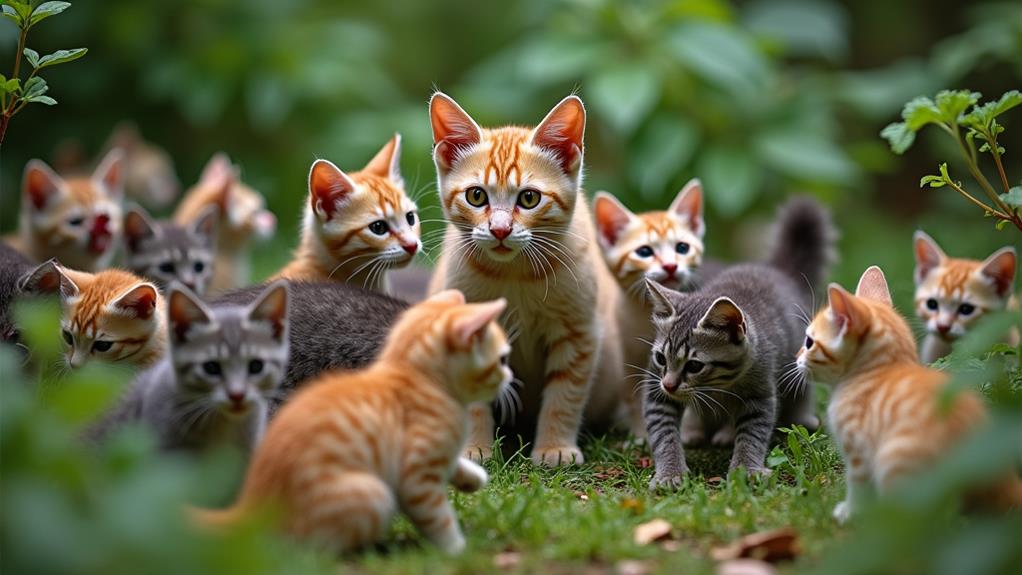
Considering the prolific nature of feral cats, their lifetime kitten production can be staggering. If you think about a single unaltered female feral cat, she can give birth to an astounding number of kittens throughout her life. On average, she produces 2 to 6 kittens per litter and about 1.4 litters each year. This means if she's left unchecked and remains healthy, a female feral cat might give birth to anywhere from 100 to 300 kittens over her lifetime.
Unlike domesticated cats, feral cats often begin reproducing as early as 4 to 5 months old. Their early sexual maturity contributes notably to their rapid reproduction rates. Imagine the multiplication effect when her offspring start reproducing; it can lead to an overwhelming number of kittens in a short time. In fact, if one unaltered female and her offspring continue to breed, the numbers can skyrocket to over 400,000 kittens in just seven years. However, it's essential to recognize that approximately 75% of these kittens won't survive past six months due to challenges like predation, disease, and scarcity of resources, highlighting the harsh realities of feral life.
Impact of Kittens on Population
The influx of kittens in feral cat populations acts like a tidal wave, rapidly swelling numbers and exacerbating the challenges of overpopulation. Each unaltered female feral cat can produce 2-6 kittens per litter, with 2-3 litters each year. This results in a staggering number of kittens, potentially leading to hundreds of thousands in just a few generations. Unfortunately, about 75% of these kittens don't survive past six months due to disease, predation, or lack of resources. However, the remaining 25% continue to increase the feral cat population, creating a cycle that's difficult to control.
Here's how this impacts the population:
- Rapid Reproduction: Each litter contributes to exponential growth, intensifying the overpopulation issue.
- Resource Strain: Limited food and shelter make survival challenging for kittens, impacting their health.
- Disease Spread: High population density facilitates the spread of diseases among feral cats.
- Predation Pressure: Increased numbers make kittens vulnerable to predators, affecting their survival rates.
- Community Challenges: Overpopulation leads to challenges in neighborhoods, including noise and property damage.
Understanding the impact of kittens on feral cat populations highlights the urgent need for effective solutions to manage this growing crisis.
TNR and Population Control
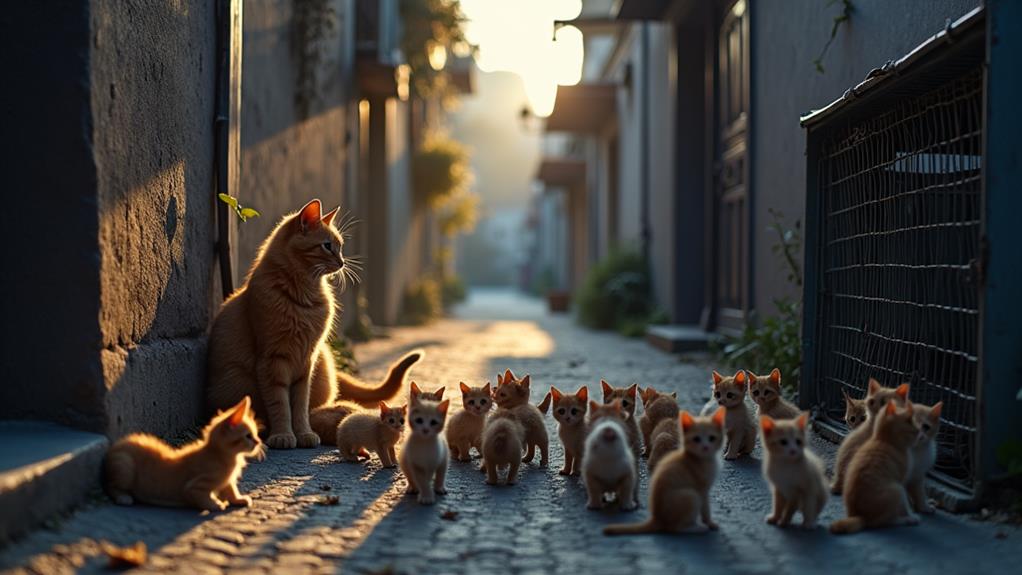
Trap-Neuter-Return (TNR) programs offer a practical solution for controlling feral cat populations by preventing the birth of unwanted litters. By spaying and neutering feral cats, TNR programs effectively reduce the number of kittens born each year. A single unaltered female feral cat can produce an average of two to three litters annually, each with two to six kittens. Without intervention, this leads to hundreds of kittens in her lifetime. TNR programs not only cut down reproductive rates but also stabilize existing feral cat colonies. Once neutered, these cats typically don't engage in mating behaviors that contribute to population growth.
Communities implementing TNR can witness significant changes. Studies show that feral cat populations can drop by 30-70% over a few years. This reduction results in fewer unwanted litters, which in turn eases the burden on local animal shelters. These shelters often face high euthanasia rates for unadoptable feral kittens. By addressing overpopulation through TNR, you're not just helping control the feral cat numbers but also reducing the strain on community resources. Ultimately, TNR programs play an essential role in creating a more balanced ecosystem and a humane solution to feral cat management.
Health Implications for Cats
TNR programs not only manage feral cat populations but also have significant health benefits for the cats themselves. By spaying and neutering, you can reduce the number of feral kittens born into environments where survival is tough. Unneutered feral cats face numerous health issues, ranging from reproductive diseases to infections like upper respiratory illnesses. When you spay or neuter feral cats, you help mitigate these challenges, ultimately enhancing their quality of life.
Consider these health implications:
- Reduced Reproductive Diseases: Spaying and neutering minimize the risk of cancers and infections related to the reproductive organs.
- Lower Kitten Mortality Rates: With fewer feral kittens born, the chances of survival for those that are born increase due to less competition for resources.
- Decreased Spread of Disease: Regular health check-ups and vaccinations curb the spread of contagious diseases, enhancing general feral cat health.
- Longer Lifespans: Cats that are not constantly breeding tend to live longer, healthier lives.
- Fewer Parasites: Managed feral cats are less likely to suffer from parasites, which are common in unmanaged populations.
Community Involvement
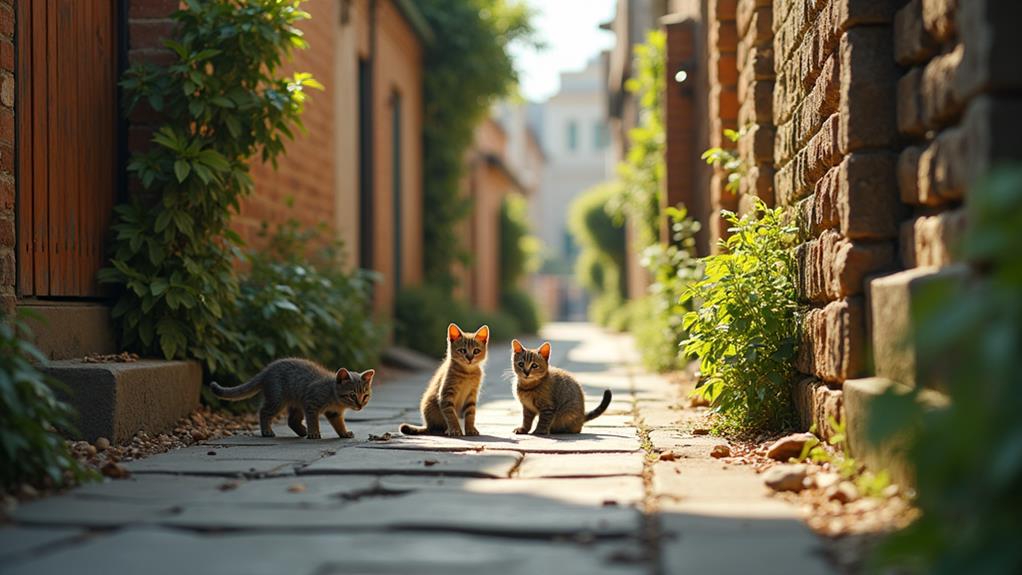
With regard to managing feral cat populations, community involvement is vital to the success of Trap-Neuter-Return (TNR) programs. By engaging local volunteers, you can effectively trap, transport, and monitor feral cats in your neighborhood. Your participation helps guarantee these programs run smoothly, reducing the number of kittens born to feral cats and ultimately improving their quality of life.
Local organizations often provide training and resources needed for those interested in caring for feral cat colonies. By taking advantage of these opportunities, you'll be well-equipped to contribute effectively to TNR programs. Furthermore, educational outreach initiatives play an important role in raising awareness about the significance of spaying/neutering and the humane treatment of feral cats. When you participate in these activities, you help create a supportive environment for community-led efforts.
Fundraising activities like bake sales or donation drives can offer vital financial support for TNR clinics and feral cat care programs. Your involvement in these efforts not only aids feral cats but also strengthens community bonds. By working together, you can foster a shared commitment to improving the lives of both feral cats and local wildlife, making a significant impact on your community.
Resources for Feral Cat Management
Many resources are available to help you manage feral cat populations effectively. Organizations like Alley Cat Allies are champions of Trap-Neuter-Return (TNR) programs, essential for controlling the number of feral cats. They provide extensive resources and advocacy to implement TNR in your community. Devine Feline offers support and guidance on caring for feral cats, with tips on feeding, shelter, and health management.
To ease the financial burden, many organizations offer low-cost spay/neuter services. These services are critical in reducing feral cat overpopulation and improving their general health. Community Services Teams, such as those reachable at 303-235-2926, can assist you with inquiries related to feral cat management and help connect you with local resources.
Educational materials and workshops on responsible cat ownership and feral cat management are widely accessible through local animal shelters and online platforms. These resources equip you with the knowledge needed to make a positive impact in your area.
- Alley Cat Allies: Advocacy and resources for TNR
- Devine Feline: Support for feral cat care
- Low-Cost Spay/Neuter Services: Reduce overpopulation
- Community Services Teams: Local resource assistance
- Educational Workshops: Learn responsible management




